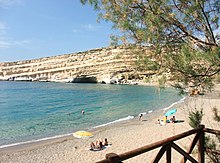Crete
From Wikipedia, the free encyclopedia
For other uses, see Crete (disambiguation).
| Native name: Κρήτη | |
|---|---|

NASA photograph of Crete
| |
| Geography | |
| Location | Eastern Mediterranean |
| Coordinates | 35.21°N 24.91°ECoordinates: 35.21°N 24.91°E |
| Area | 8,303 km2 (3,206 sq mi) |
| Area rank | 89 |
| Highest elevation | 2,456 m (8,058 ft) |
| Highest point | Mount Ida |
| Country | |
| Region | Crete |
| Capital city | Heraklion |
| Largest settlement | Heraklion (pop. 173,993) |
| Demographics | |
| Demonym | Cretan |
| Population | c. 620,000 (as of 2011) |
| Population rank | 73 |
Crete (Greek: Κρήτη, Kríti ['kriti]; Ancient Greek: Κρήτη, Krḗtē) is the largest and most populous of the Greek islands, and the fifth-largest island in the Mediterranean Sea, after Sicily, Sardinia, Cyprus, and Corsica. Crete and a number of surrounding islands and islets constitute the region of Crete (Greek: Περιφέρεια Κρήτης), one of the 13 top-level administrative units of Greece. The capital and the largest city is Heraklion. As of 2011, the region had a population of 623,065.
Crete forms a significant part of the economy and cultural heritage of Greece, while retaining its own local cultural traits (such as its own poetry and music). It was once the centre of the Minoan civilization (c. 2700–1420 BC), which is currently regarded as the earliest recorded civilization in Europe.[1]
Climate[edit]
Main article: Climate of Greece
Crete straddles two climatic zones, the Mediterranean and the North African, mainly falling within the former. As such, the climate in Crete is primarily Mediterranean. The atmosphere can be quite humid, depending on the proximity to the sea, while winter is fairly mild. Snowfall is common on the mountains between November and May, but rare in the low-lying areas. While mountain tops remain snow-capped year long, near the coast snow only stays on the ground for a few minutes or hours. However, a truly exceptional cold snap swept the island in February 2004, during which period the whole island was blanketed with snow. During the Cretan summer, average temperatures reach the high 20s-low 30s Celsius (mid 80s to mid 90s Fahrenheit), with maxima touching the upper 30s-mid 40s.
The south coast, including the Mesara Plain and Asterousia Mountains, falls in the North African climatic zone, and thus enjoys significantly more sunny days and high temperatures throughout the year. There, date palms bear fruit, and swallows remain year-round rather than migrate to Africa. The fertile region around Ierapetra, on the southeastern corner of the island, is renowned for its exceptional year-round agricultural production, with all kinds of summer vegetables and fruit produced in greenhousesthroughout the winter.[16]
Cities[edit]
Main article: Cities of Greece
Heraklion is the largest city and capital of Crete. The principal cities are:
- Heraklion (Iraklion or Candia) (173,993 inhabitants)[20]
- Chania (Haniá) (53,373 inhabitants)[20]
- Rethymno (27,868 inhabitants)[20]
- Ierapetra (23,707 inhabitants)
- Agios Nikolaos (19,462 inhabitants)
- Sitia (14,338 inhabitants)
Tourism[edit]
Main article: Tourism in GreeceCrete is one of the most popular holiday destinations in Greece. Fifteen percent of all arrivals in Greece come through the city of Heraklion(port and airport), while charter journeys to Heraklion last year made up 20% of all charter flights in Greece.[citation needed] Overall, more than two million tourists visited Crete last year,[when?] and this increase in tourism is reflected on the number of hotel beds, rising by 53% in the period between 1986 and 1991, when the rest of Greece saw increases of only 25%.Today, the island's tourism infrastructure caters to all tastes, including a very wide range of accommodation; the island's facilities take in large luxury hotels with their complete facilities, swimming pools, sports and recreation, smaller family-owned apartments, camping facilities and others. Visitors reach the island via two international airports in Heraklion and Chania and a smaller airport in Sitia(international charter and domestic flights starting May 2012)[25] or by boat to the main ports of Heraklion, Chania, Rethimno, Agios Nikolaos and Sitia.Popular tourist attractions include the archaeological sites of the Minoan civilisation, the Venetian old city and port of Chania, the Venetian castle at Rethymno, the gorge of Samaria, the islands of Chrysi, Elafonisi, Gramvousa, and Spinalonga and the Palm Beach of Vai, which is the largest natural palm forest in Europe.he island has three significant airports, Nikos Kazantzakis at Heraklion, the Daskalogiannis airport at Chania and a smaller one in Sitia. The first two serve international routes, acting as the main gateways to the island for travellers. There is a long-standing plan to replace Heraklion airport with a completely new airport at Kastelli, where there is presently an air force base.The island is well served by ferries, mostly from Athens, by ferry companies such as Minoan Lines and ANEK Lines.Although the road network leads almost everywhere, there is a lack of modern highways, although this is gradually changing with the completion of the northern coastal spine highway.[citation needed]



Δεν υπάρχουν σχόλια:
Δημοσίευση σχολίου